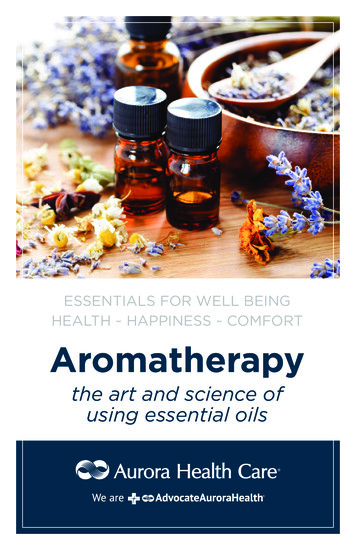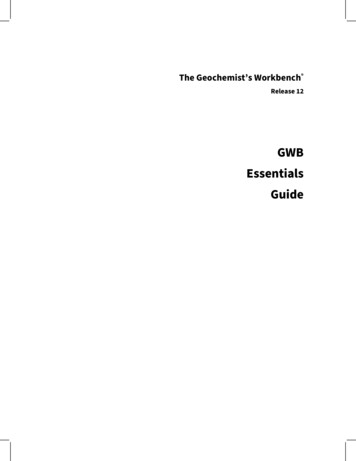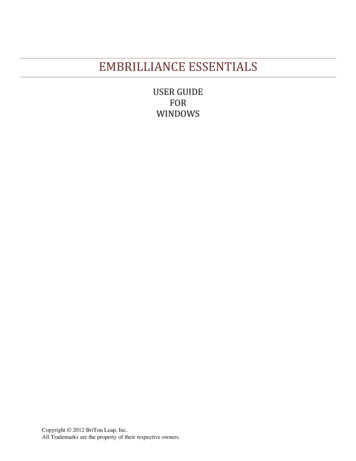
Transcription
ESSENTIALS FOR WELL BEINGHEALTH HAPPINESS COMFORTAromatherapythe art and science ofusing essential oils
ESSENTIALS FOR WELL BEINGAromatherapy every dayWhat is aromatherapy?Aromatherapy is the art and science of usingpure essential oils extracted from naturalplants and flowers. Essential oils are used tocalm, balance and give energy to the body,mind and spirit.Other conditions for whichessential oils may be usefulinclude headaches, gingivitis,sinusitis, insomnia, supportfor the immune system, coldand flu, burns, insect bites,and various skin conditions.What are essential oils?Essential oils are obtained from flowers,plants, trees, shrubs and roots or from thepeels of fruits. The oils are either steamdistilled or expressed. The climate, weatherand temperature at distillation can affect thequality of the oil, which in turn will affect thechemical structure.When using essential oils for personal andhealth-related care, it is best to use plantparts that are free from toxic chemicals,such as pesticides or herbicides.Toxic chemicals applied togrowing plants can react withthe oils made and createa poor or toxic essentialoil. Sometimes oils aremixed with products likealcohol or other manmade chemicals to createperfumes or lotions.While the scent fromthese products may bepleasant, the health effectsmay not be. Look for pureessential oils when buyingfor health reasons.How does aromatherapy work?At the most basic level, aromatherapy works by affecting our senseof smell. Scent connects us with our emotions, feelings, creativity andintuition. A scent can bring us into our body and help us to rememberpowerful feelings. Beautiful scents can balance our mood, and lift ourspirits and emotions. Additionally, essential oils have been used inmedicine to help heal the body when infected by bacteria, viruses andfungi.Who uses essential oils?Aromatherapy is used in the home, workplace, retail environment andin health care. Trained health-care professionals use essential oils incombination with conventional medicine. For instance, an infectedwound or a skin and soft tissue infection may need an antibiotic, but anessential oil may also be applied topically as adjunctive therapy. Manyessential oils possess antifungal, antibacterial and antiviral properties.
ESSENTIALS FOR WELL BEINGAromatherapy user guideLavender(Lavandula angustifolia)Peppermint(Mentha piperita)Lemon(Citrus limon)Tea Tree(Melaleuca alternifolia)Lavender is noted for its floralscent and woody undertonesand is one of the mostcommonly used essentialoils in the world today. Thisrefreshing and balancing aromais frequently used for relaxation.Other common uses includemanagement of anxiety, insomnia,burns, infections, wounds,candida and insect bites.Enjoy this refreshing and mentallystimulating essential oil. Its mintyfresh scent is easy to recognizeand is frequently an ingredient ingum, candy and herbal teas.Lemon is often selected forits pleasant, crisp and cleanscent. Mental alertness may beincreased with the diffusion oflemon into the environment. Itis also uplifting and sharpensour focus with decision-making.Use this oil in the morning orafternoon to promote energylevels. Additionally, lemon hasantiseptic properties.Tea tree oil is highly regarded andone the world’s most researchedessential oils for its medicinalproperties. The pungent odorassociated with tea tree oilis similar to eucalyptus andcamphor. Tea tree oil is commonlyused to treat skin infections,wounds, ringworm, cold sores,acne, mouth/throat infections,toenail fungus, athlete’s foot,psoriasis, dandruff and head lice.Therapeutic properties:Analgesic, antibacterial,antidepressant, anti-inflammatory,antifungal, antiviral, antispasmodicApplications:Inhalation, diffusion, compress,bath, massage, direct applicationto skinTherapeutic properties:Analgesic, expectorant,antispasmodic and anti-nauseaApplications:Inhalation, diffusion, bath,massage. Always mix with acarrier oil if applying directlyto the skin. Avoid internal use,especially for those with G6PDdeficiency, atrial fibrillation, postcardiac surgery and on 5-FUchemotherapy.Therapeutic properties:Antiviral, antibacterial, astringent,tonic, antispasmodic, antiseptic,diureticTherapeutic properties:Applications:Applications:Massage, bath, inhalation,diffusion. Always mix with acarrier oil if applying directly tothe skin. Avoid sun exposure aftertopical application, as this oil isphototoxic.Inhalation, diffusion, compress,direct application to the skin.Do not apply to skin undilutedwithout a patch test to check forallergies and skin sensitivities. Mayuse undiluted on skin if no allergicresponse is present.Antifungal, antibacterial, antiviral,wound-healingPOSITIVE AFFIRMATIONI am peaceful I am calmI am able to achieve a restful state
Bergamot (Citrus bergamia)Rosemary (Rosmarinus officinalis)Try this fresh citrus scent with slightly spicy undertones to lift yourmood and stimulate your immune system. You may recognize this scentif you like Earl Grey tea. Bergamot mixes well with other citrus scentsproviding a fragrant, mellow sensory experience. It is beneficial forreducing symptoms of stress, anxiety, depression and acne.The sharp woody scent of rosemary conveys a feeling of warmth.This stimulating oil is used to increase energy, improve mental clarityand offer an alert state. Rosemary is helpful in relieving respiratorycongestion and muscular aches and pain.Therapeutic properties;Mild stimulant, analgesic, anti-inflammatoryAntispasmodic, sedative, analgesic, antidepressant, tonic, antifungalApplications:Inhalation, diffusion, compress, bath and massage. Avoid sun exposureafter topical application, as this oil is phototoxic.Therapeutic properties:Applications:Inhalation, diffusion, massage, compress, bath and direct application tothe skin with a carrier oil. Avoid with hypertension and seizure disorders.Ginger (Zingiber officinale)Eucalyptus (Eucalyptus globulus)The familiar, sharp and somewhat pungent scent of eucalyptus is easilyrecognized and found in many over-the-counter drug store products.Eucalyptus oil is effective for symptom relief from the common coldand sinus congestion by acting as a decongestant. This oil is coolingand increases mental concentration and alertness.When you think of ginger, you may think about food. Indeed, ginger isoften used in cooking and baking. The essential oil of ginger offers apeppery, sharp and yet warm aromatic scent. The warmth associatedwith ginger is good for reducing symptoms such as joint swellingassociated with arthritis. Ginger settles the digestive system andrelieves nausea, including morning sickness.Therapeutic properties:Therapeutic properties:Antibacterial, antiviral, analgesicAnti-emetic, anti-inflammatory, analgesic, antispasmodicApplications:Applications:Inhalation, diffusion, steam bath, compress and massage. Always mixwith a carrier oil if applying directly to the skin.Inhalation, bath, massage, compress and direct application to the skinwith a carrier oil.Geranium (Pelargonium graveolens)Mandarin (Citrus reticulata)Enjoy this herb-like fragrance that features a subtle combination ofrose, citrus and woody undertones. Geranium’s scent is physically andemotionally balancing, and helps to reduce stress and anxiety. This oilis popular among women for hormonal-related problems such as PMS,fluid retention and menopausal symptoms. Geranium is also helpful fordermatitis, wound healing, inflammation, eczema, burns, ringworm andinsomnia.This is one of the gentlest and safest essential oils impacting the body,mind and spirit. Mandarin offers a calming influence that promotesrestful sleep, and is especially good for children and the elderly. This oilbrings out joy, lifts moods and reduces irritability.Therapeutic properties:Applications:Sedative, antibacterial, antiviral, anti-inflammatory, antifungalInhalation, dilution, bath, massage, compress and direct application tothe skin with a carrier oil. Avoid sun exposure after topical application,as this oil may be mildly phototoxic.Applications:Inhalation, diffusion, baths, massage and direct application to the skinwith a carrier oil.Therapeutic properties:Anti-nausea, astringent, digestive, diuretic, relaxant, sedative.
ESSENTIALS FOR WELL BEINGAromatherapy applicationsScenting a roomDirect inhalationScenting an entire room requires a diffuser. A diffuser is a devicethat gently heats or blows air across the oil and into the air. Diffusersvary by manufacturer, and it is best to follow the manufacturer’sguidelines for use. One to eight drops of pure essential oil placed ona pad in the diffuser is often recommended (less is best).Inhalation is a very effective method to receive the benefits of essentialoils. Place three drops of the preferred essential oil on a tissue or cottonball and inhale. Repeat as necessary. Extend the use and portabilityof the direct inhalation experience by placing a tissue or cotton ballinto a small plastic bag. Carry the small bag with you in your pocket,purse, gym bag or place on your desk. This method works well for sinuscongestion, stress and anxiety. Try eucalyptus for sinus congestion andlavender or mandarin to reduce stress and anxiety.Never mix a carrier oil and essential oil together and use in adiffuser. Create your own special blend by mixing different essentialoils together and then place on the pad in the diffuser.You can save the scent by removing the pad when not in use andstoring in a plastic bag. To create a fresh scent in a small area, placea cotton ball in small cup and add one or two drops of essential oil.This is a great way to scent your personal workspace.Warm compressA soothing scented compress is easily made by placing five drops ofessential oil in three ounces of warm water. Stir solution. Dip foldedcotton cloth or washrag into solution and wring out. Apply to desiredarea. Repeat as desired. This application is wonderful for cramps,headaches, muscle aches and pains.MassageThe ability to create a soothing experience for the body through thesense of smell and touch is achieved when using essential oils withmassage. This approach is ideal for stress, tension and loving touch. Fora full body massage, mix 3 to 5 drops of essential oil in 2 to 4 teaspoonsof carrier oil. Lavender oil is easy to begin with and provides a relaxingexperience. Carrier oils recommended for this includes grapeseed,sesame, jojoba and sweet almond. Avoid mineral and hydrogenated oils.ShowerCreate a scented steam room in the comfort of your home whenusing essential oils with your shower experience. Place 3 to 5 drops ofessential oil on the wall or perimeter of your shower stall. The steamwill help release the scent. This method works well for sinus congestionwhen eucalyptus oil is selected.BathsAromatic baths can promote relaxation and a sense of well being andare especially good for stress conditions and those with insomnia.Additionally, a soak in a tub can be beneficial for skin and inflammatoryconditions, aches and pains and sore muscles. Mix 5 to 10 drops ofessential oils in Epsom salt, unscented liquid soap or milk before puttinginto the water. The oil will bind to the salt, soap or milk and then mixwith the bath water. Do not add oil directly to bath water. The oil willfloat on top of the water and put you at risk for an eye splash.
ESSENTIALS FOR WELL BEINGAromatherapy solutions and rGeraniumLemonMandarinLavenderPeppermintRoman ngalInfectionsLavenderEucalyptusBlack PepperGeraniumJuniperTea TreeLavenderAcneNauseaTea TreeAnxiety/RelaxationConstipationBlack pepperRosemaryBergamotSweet ral/Cold/Flu8.Lemon Peel9.PeppermintRavensaraSpike LavenderTea Tree10.Essential oils are not water-soluble. Avoid contact with eyes. If a splashoccurs, use a small amount of milk, baby shampoo or a carrier oil toabsorb the oil from the eye area, then rinse with water for 5 minutes.Wash your hands before and after using essential oils.Do not use internally unless directed by a trained health carepractitioner.Patch test prior to applying directly to skin to check for allergy. Topatch test: Mix 2 to 5 drops of essential oil in 1 teaspoon of carrier oilsuch as grapeseed or olive oil. Put 2 to 5 drops of the solution on thewhite part of a bandage and apply to the inner forearm. Remove thebandage after 12 to 24 hours. If no redness or inflammation occurs atthe site, you may move ahead and apply to skin. You do not need topatch test for inhalation.The majority of oils should be mixed with a carrier oil such asgrapeseed or olive oil. Oils such as tea tree, lavender, petitgrain andGerman chamomile may be used straight on the skin if no allergyexists.Medical history is important. Individuals with known kidney or liverfailure, history of estrogen-based cancer, seizure disorder, asthma,hypertension, tachycardia, post-cardiac surgery or receivingchemotherapy need to express caution with certain oils and consult acertified clinical aromatherapy health care practitioner.Photosensitivity may occur with citrus oils, causing a sunburn or rash.It is best to avoid applying citrus oils to skin exposed to sunlight.Certain oils should not be used with children and pregnant women.Consult with a trained health care practitioner for appropriate use.Do not self diagnose. Consult your provider for a diagnosis and workwith a qualified aromatherapist for clinical use.Aromatherapy is not a substitute for medical care.Essential oils to avoid with certain conditions Hypertension: hyssop, rosemary, sage, thymeSeizure disorder: hyssop, sage, fennel, rosemary, spike lavenderEstrogen dependent cancers: clary sage, fennelAsthmatics should use a diluted mixture of essential oils at first to avoidadverse reactions Skin irritants: thyme, cinnamon, clove and birch are examples of oils thatcannot be used directly on the skin Pregnancy: Do not use if pregnant, unless under the guidance of apractitioner
PROMOTING SELF CAREmind body spirit energyAROMATHERAPYkeeping youhappy,healthy andloving lifeAurora lntegrative Medicine414-219-5900aurora.orgKV0812 (1/20)
What are essential oils? Essential oils are obtained from fl owers, plants, trees, shrubs and roots or from the peels of fruits. The oils are either steam distilled or expressed. The climate, weather and temperature at distillation can aff ect the quality of the oil, which in turn will aff ect the chemical











